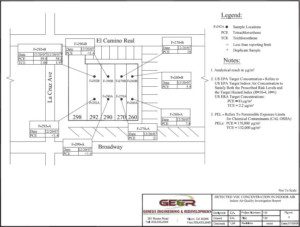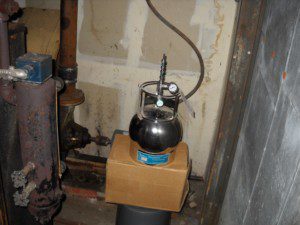Genesis Engineering & Redevelopment, LLC (GE&R) has special expertise in vapor intrusion evaluation and mitigation. With growing concerns over indoor air quality and the associated impacts from vapors migrating from nearby soil and/or groundwater, local, state, and federal regulators are requiring thorough soil vapor (or soil gas) investigation to ensure the human health and the environment are protected.

Our Program:
GE&R’s scientists and engineers have worked on hundreds of vapor intrusion sites across the country. We have pioneered innovative methods to screen out sites, providing accurate and efficient testing of both groundwater and indoor air, designing and implementing cost-effective mitigation systems, attracting regulatory and community support.
EPA has developed protocols that go beyond the effectiveness outlined in current guidance documents. Our skills and experience allow us to:
- Rapidly screen sites to avoid unnecessary costs for site owners and to identify potential liabilities for buyers
- Maximize the use of existing data and limit the need for indoor air tests
- Rule out vapor intrusion sources based on our modeling indoor air concentrations of solvents and other compounds
- Provide low cost, effective mitigation when required
- Make credible presentations to regulators and the public

Our Program:
GE&R provides complete and comprehensive vapor intrusion services, including:
- Site Screening and Modeling
- Pathway and Plume Evaluation
- Indoor Air Testing
- Source Identification
- Risk Assessment
- Mitigation
- Community Relations
- Expert Testimony
Site Screening and Modeling
Not all groundwater plumes have the potential to cause vapor intrusion. Based on our experience and various screening models, GE&R’s experts can screen one or multiple sites for the potential to cause vapor intrusion, avoiding unnecessary testing and prioritizing action at sites where the potential may exist.
When site screening indicates the potential for vapor intrusion, in order to keep cost in line, subsequent field investigations need to be as efficient and focused as possible. Our experience with passive soil vapor, active soil vapor, groundwater and indoor air testing allows us to rapidly evaluate complex sites, using each method as appropriate for both groundwater and indoor air plume delineation.

Indoor Air Testing:
GE&R’s soil vapor experts have conducted thousands of state-of-the-art indoor air tests for the vapor intrusion sites across the country. When testing is necessary, you can be sure that the proper procedures, laboratories, and quality assurance protocols will be provided, and that the resulting data will be defensible. In addition, GE&R has the experience and systems in place to conduct cost effective testing, including access and scheduling, essential occupant survey forms, electronic data transfer, and GIS based reporting services.
Source Identification
Many common household products are sources of chlorinated solvents, often resulting in elevated indoor air concentrations. Great care must be exercised when conducting indoor air tests to ensure that these background sources are properly considered. Although limited background data for indoor air concentrations of chlorinated solvents are available in the literature, our experience has provided us with a substantial database of background concentrations that can be applied to other sites. Without this information, agencies may require testing and mitigation far beyond the zone of vapor intrusion or, in some cases, where no vapor intrusion occurs at all. Our experience with multivariate statistical techniques, combined with GIS exhibits, can provide convincing demonstrations of the role of “background” indoor air sources at a site.
GE&R and its expert team members have extensive experience conducting risk assessments for both organics and metals, and unique experience negotiating realistic indoor air action levels with both state agencies and the U.S. EPA. We ensure that the decision-making process, whether to require testing, expanded testing, or mitigation, accounts for indoor sources and background levels.
Prior to our work mitigating several hundred homes, little was known about the abilities of sub-slab venting systems to achieve the very low action levels required for indoor air remediation. We now know that standard radon venting systems, if properly installed, can achieve low action levels in most buildings with full basement, crawl space, and slab on grade construction. In the remaining cases, we have found that simple and inexpensive modifications will allow radon-venting systems to mitigate the effects of vapor intrusion and achieve indoor air action levels. We have the experience necessary to ensure that both single-family home remediation systems and larger commercial systems will be effective and economical.
Vapor intrusion potentially affects the indoor air of residences – a sensitive issue that must be handled with care and integrity. We have years of experience at sites addressing the concerns of the public, while honoring the legitimate concerns of clients. Our community relations experts develop proactive strategies that diffuse public outrage and gain community cooperation. Our tools include community relations plans, public forums, project websites, newsletters, and meetings with government officials and community leaders. We have the expertise to create GIS based maps and other graphics that are both informative and persuasive. We work with physicians and real estate experts who can address the concerns of residents.
